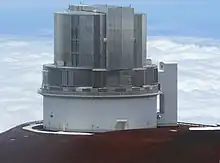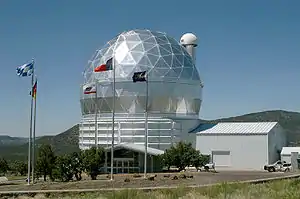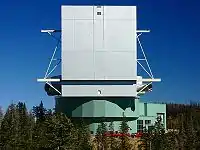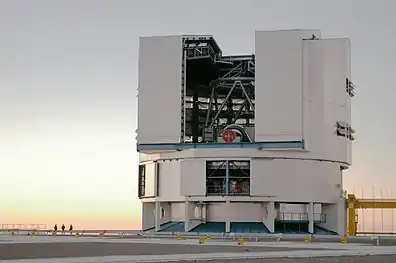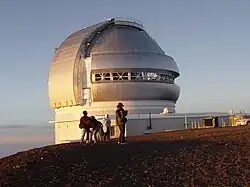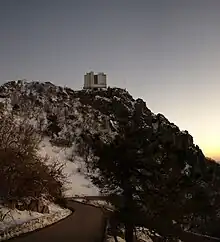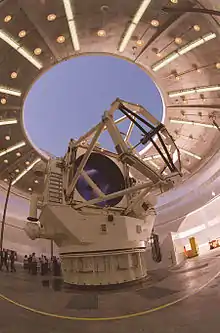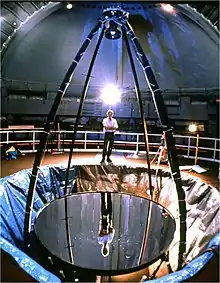This list of the largest optical reflecting telescopes with objective diameters of 3.0 metres (120 in) or greater is sorted by aperture, which is a measure of the light-gathering power and resolution of a reflecting telescope. The mirrors themselves can be larger than the aperture, and some telescopes may use aperture synthesis through interferometry. Telescopes designed to be used as optical astronomical interferometers such as the Keck I and II used together as the Keck Interferometer (up to 85 m) can reach higher resolutions, although at a narrower range of observations. When the two mirrors are on one mount, the combined mirror spacing of the Large Binocular Telescope (22.8 m) allows fuller use of the aperture synthesis.
Largest does not always equate to being the best telescopes, and overall light gathering power of the optical system can be a poor measure of a telescope's performance. Space-based telescopes, such as the Hubble Space Telescope, take advantage of being above the Earth's atmosphere to reach higher resolution and greater light gathering through longer exposure times. Location in the northern or southern hemisphere of the Earth can also limit what part of the sky can be observed, and climate conditions at the observatory site affect how often the telescope can be used each year.
The combination of large mirrors, locations selected for stable atmosphere and favorable climate conditions, and active optics and adaptive optics to correct for much of atmospheric turbulence allow the largest Earth based telescopes to reach higher resolution than the Hubble Space Telescope.[1] Another advantage of Earth based telescopes is the comparatively low cost of upgrading and replacing instruments.
Table of reflecting telescopes
This list is ordered by optical aperture, which has historically been a useful gauge of limiting resolution, optical area, physical size, and cost. Multiple mirror telescopes that are on the same mount and can form a single combined image are ranked by their equivalent aperture. Fixed altitude telescopes (e.g. HET) are also ranked by their equivalent aperture. All telescopes with an effective aperture of at least 3.00 metres (118 in) at visible or near-infrared wavelengths are included.
There are only a few sites capable of polishing the mirrors for these telescopes. SAGEM in France polished the four VLT mirrors, the two Gemini mirrors, and the 36 segments for GTC.[17] The Steward Observatory Mirror Lab cast and polished the two LBT mirrors, the two Magellan mirrors, the MMT replacement mirror, and the LSST primary/tertiary mirror. It is currently making the mirrors for the Giant Magellan Telescope.[18] The Keck segments were made by Schott AG. The SALT and LAMOST segments were cast and polished by LZOS.[19] The mirror for Subaru was cast by Corning and polished at Contraves Brashear Systems in Pennsylvania, USA.[20]
This table does not include all the largest mirrors manufactured. The Steward Observatory Mirror Lab produced the 6.5 metre f/1.25 collimator used in the Large Optical Test and Integration Site of Lockheed Martin, used for vacuum optical testing of other telescopes.
Segmented mirrors are also referred to as mosaic mirrors. Single mirrors are also referred to monolithic mirrors, and can be sub-categorized in types, such as solid or honeycomb.

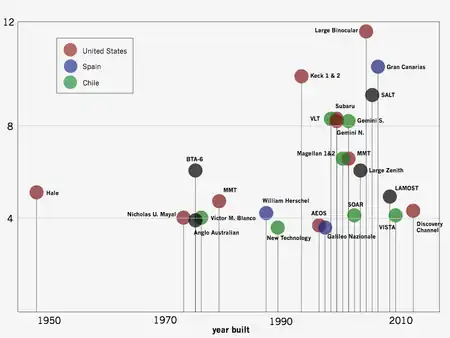
Chronological list of largest telescopes
These telescopes were the largest in the world at the time of their construction, by the same aperture criterion as above.
| Years Largest | Name | Out | In | Aperture (m) | Area (m2) | M1 Mirror | Note | Altitude (m) |
|---|---|---|---|---|---|---|---|---|
| 2009–Present | Gran Telescopio Canarias |  | 10.4 | 74 | 36 × 1.9 m hexagons M1 mirror | Segmented mirror | 2267 | |
| 1993–2009 | Keck 1 | 10 | 76 [21] | 36 × 1.8 m hexagons M1 mirror | Segmented mirror, M1 f/1.75 | 4145 | ||
| 1976–1993 | BTA-6 | 6 | 26 | 605 cm f/4 M1 mirror | Mirror replaced twice | 2070 | ||
| 1948–1976 | Hale (200 inch) | 5.1 | – | 508 cm f/3.3 M1 mirror | Art deco dome | 1713 | ||
| 1917–1948 | Hooker (100 inch) | 2.54 | – | Also used for 1st optical interferometer | 1742 | |||
| For earlier entries, see List of largest optical telescopes historically | ||||||||
Future telescopes
Under construction
.jpg.webp)
These telescopes are under construction and will meet the list inclusion criteria once completed:
- Extremely Large Telescope, Chile – 39.3 m (1,550 in). Construction began in 2018, first light planned in 2028.[22]
- Thirty Meter Telescope, Hawaii, USA – 30 m (1,200 in). Construction began in 2014 but halted in 2015; as of 2022 it has not resumed.[23]
- Giant Magellan Telescope, Chile – seven 8.4 m mirrors on a single mount. This provides an effective aperture equivalent to a 21.4 m mirror and the resolving power equivalent to a 24.5 m mirror. First light planned in 2029.[24]
- Vera C. Rubin Observatory, Chile – 8.4 m (330 in). First light planned in 2024.[25]
- San Pedro Martir Telescope, Baja California, Mexico – 6.5 m (260 in). First light planned in 2023.[26]
- Tokyo Atacama Observatory (TAO) – 6.5 m (260 in). First light planned for 2023.[27]
- Magdalena Ridge Observatory Interferometer, New Mexico, USA – An optical interferometer array with ten 1.4 m (55 in) telescopes. The light gathering power is equivalent to a 4.4 m (170 in) single aperture. The first telescope was installed in 2016; construction was paused in 2019 due to insufficient funding[28] and has not resumed.
- Timau National Observatory, Indonesia – 3.8 m (150 in). Construction expected to be completed in 2023.[29]
Proposed

Selected large telescopes which are in detailed design or pre-construction phases:
- Large UV Optical Infrared Surveyor (LUVOIR), a proposed space telescope for launch in the mid 2030s.
- MUltiplexed Survey Telescope (MUST), a 6.5 m spectroscopic survey telescope.[30]
- Chinese Giant Solar Telescope (CGST), an infrared and optical solar telescope, with light-gathering power equivalent to a 5 m diameter aperture.[31][32]
- Advanced Liquid-mirror Probe of Astrophysics, Cosmology and Asteroids (ALPACA), a proposed Earth-based 8 metre telescope, by Arlin Crotts of Columbia University.[33][34]
See also
References
- ↑ "Neptune from the VLT and Hubble". www.eso.org. Retrieved 2021-02-23.
- ↑ SPIE 2006 in Orlando – Proceedings of SPIE conference 6267 on "Ground-based and Airborne Telescopes", "The Large Binocular Telescope", John M. Hill, Richard F. Green and James H. Slagle
- ↑ "Upgraded Hobby–Eberly Telescope Sees First Light". McDonald Observatory. Retrieved 2016-07-29.
- ↑ "Howstuffworks "10 Amazing Telescopes"". Science.howstuffworks.com. Archived from the original on December 22, 2008. Retrieved August 19, 2009.
- ↑ "The Carnegie Observatories – Magellan Telescopes". Carnegie Institution for Science. Retrieved 2017-05-24.
- ↑ Andersen, Geoff. The Telescope, p. 165
- ↑ Archived July 22, 2011, at the Wayback Machine
- ↑ "LAMOST Homepage – Gallery". Lamost.org. August 13, 2012. Retrieved January 6, 2018.
- ↑ Dwayne DayMonday, May 11, 2009 (2009-05-11). "Mirrors in the dark". The Space Review. Retrieved 2012-01-03.
{{cite web}}: CS1 maint: multiple names: authors list (link) CS1 maint: numeric names: authors list (link) - ↑ Lowell Observatory – 4.3-meter DCT
- ↑ "The Mayall 4-Meter Telescope". Noao.edu. February 27, 1973. Retrieved August 19, 2009.
- ↑ Sagar, Ram; Kumar, Brijesh; Omar, Amitesh; Pandey, A. K. (2012). Stepp, Larry M.; Gilmozzi, Roberto; Hall, Helen J. (eds.). "New optical telescope projects at Devasthal Observatory". Proceedings of the Society of Photo-Optical Instrumentation Engineers. Ground-based and Airborne Telescopes IV. 8444: 84441T. arXiv:1304.2474. Bibcode:2012SPIE.8444E..1TS. doi:10.1117/12.925634. S2CID 119272065.
- ↑ "Max-Planck-Institut für Astronomie". Mpia.de. July 20, 1994. Retrieved August 19, 2009.
- ↑ Pike, John. "Starfire". Globalsecurity.org. Retrieved August 19, 2009.
- ↑ Stone, Richard (19 October 2022). "'The door is open': Iranian astronomers seek collaborations for their new, world-class telescope". Science. doi:10.1126/science.adf4145. Retrieved 21 October 2022.
- ↑ "NASA Orbital Debris Observatory". Astro.ubc.ca. Retrieved August 19, 2009.
- ↑ "Polissage Optique pour les Grands Instruments de la Physique et de l 'Astronomie" (PDF). Archived from the original (PDF) on 2012-04-26.
- ↑ "Mirror Castings". Steward Observatory Mirror Lab.
- ↑ "Large Optics Manufacturing in Large Optics Manufacturing in Lytkarino Optical Glass Factory, Russia" (PDF). Archived from the original (PDF) on 2012-04-26.
- ↑ "SUBARU Telescope 8.3m Primary Mirror Finished".
- ↑ "Keck Telescope Facts". Spacecraftkits.com. Retrieved 2012-01-03.
- ↑ "Timeline". The Extremely Large Telescope. European Southern Observatory. Retrieved 2023-09-03.
- ↑ "Timeline". TMT International Observatory. Retrieved 27 September 2022.
- ↑ "Quick Facts". Gmto.org. Retrieved 2021-02-15.
- ↑ "Construction Project Status". Rubin Observatory. 16 October 2022. Retrieved 17 October 2022.
14-Mar-2024 System First Light
- ↑ Universities in U.S. and Mexico Partner on Telescope Project. Arizona Public Media, 13 November 2017.
- ↑ Yoshii, Y.; Doi, M.; Kohno, K.; Miyata, T.; Motohara, K.; Kawara, K.; Tanaka, M.; Minezaki, T.; Sako, S.; Morokuma, T.; Tamura, Y.; Tanabe, T.; Takahashi, H.; Konishi, M.; Kamizuka, T.; Kato, N.; Aoki, T.; Soyano, T.; Tarusawa, K.; Handa, T.; Koshida, S.; Bronfman, L.; Ruiz, M. T.; Hamuy, M.; Garay, G. (2016). Hall, Helen J; Gilmozzi, Roberto; Marshall, Heather K (eds.). "The University of Tokyo Atacama Observatory 6.5m telescope: Project overview and current status". Ground-Based and Airborne Telescopes VI. 9906: 99060R. Bibcode:2016SPIE.9906E..0RY. doi:10.1117/12.2231391. hdl:10150/632264. S2CID 124828278.
- ↑ Creech-Eakman, Michelle J.; Romero, V. D.; Haniff, Christopher A.; et al. (13 December 2020). Setting the stage for first fringes with the Magdalena Ridge Observatory Interferometer. Optical and Infrared Interferometry and Imaging VII. Proceedings of the SPIE. Vol. 11446. p. 1144609. Bibcode:2020SPIE11446E..09C. doi:10.1117/12.2563173.
- ↑ "Pembangunan Observatorium Nasional Timau segera Rampung". brin (in Indonesian). 2023-07-30. Retrieved 2023-09-13.
- ↑ Zhang, Yifan; Jiang, Haijiao; Shectman, Stephen; Yang, Dehua; Cai, Zheng; Shi, Yong; Huang, Song; Lu, Lu; Zheng, Yamin; Kang, Shaonan; Mao, Shude; Huang, Lei (2023). "Conceptual design of the optical system of the 6.5m wide field multiplexed survey telescope with excellent image quality" (PDF). PhotoniX. 4 (4): 16. doi:10.1186/s43074-023-00094-4. S2CID 258766165.
- ↑ "Introduction to the Chinese Giant Solar Telescope" (PDF).
- ↑ Staff (29 August 2012). "China Exclusive: Scientists looking for site for giant solar telescope". Retrieved 8 December 2014.
- ↑ Shiga, David (2 June 2008). "Liquid-mirror telescopes are a reality at last". New Scientist. Retrieved 18 June 2022.
- ↑ "Advanced Liquid-mirror Probe of Astrophysics, Cosmology and Asteroids)". Liquid-Mirror Telescope. Astronomy and Astrophysics at the University of British Columbia. Retrieved 18 June 2022.
Further reading
- Racine, René (2004). "The Historical Growth of Telescope Aperture". Publications of the Astronomical Society of the Pacific. 116 (815): 77. Bibcode:2004PASP..116...77R. doi:10.1086/380955.


